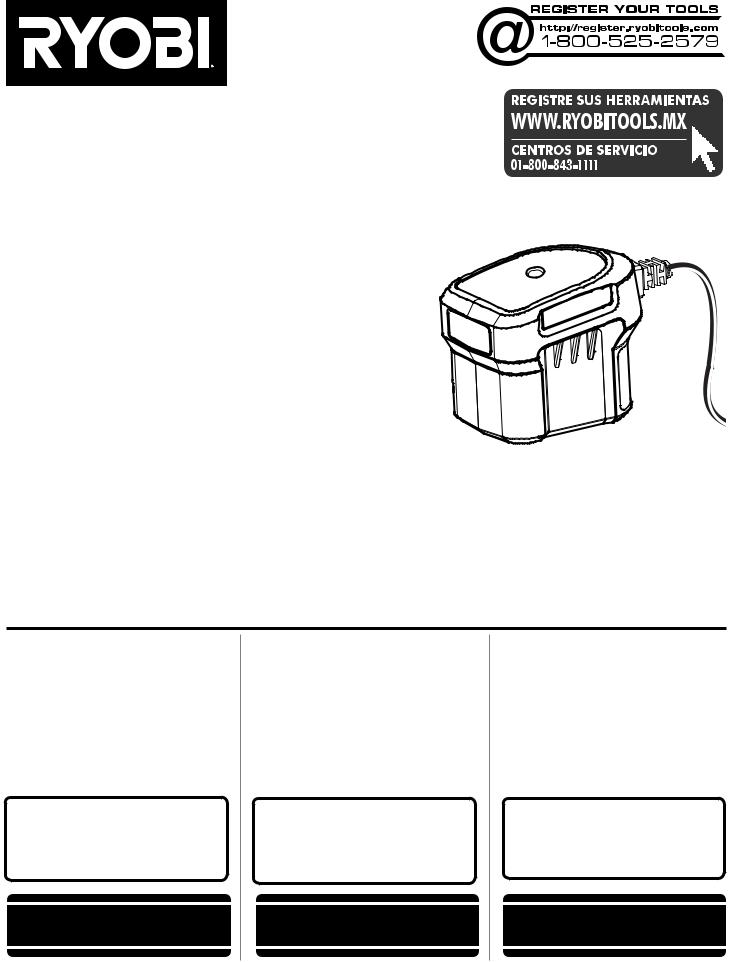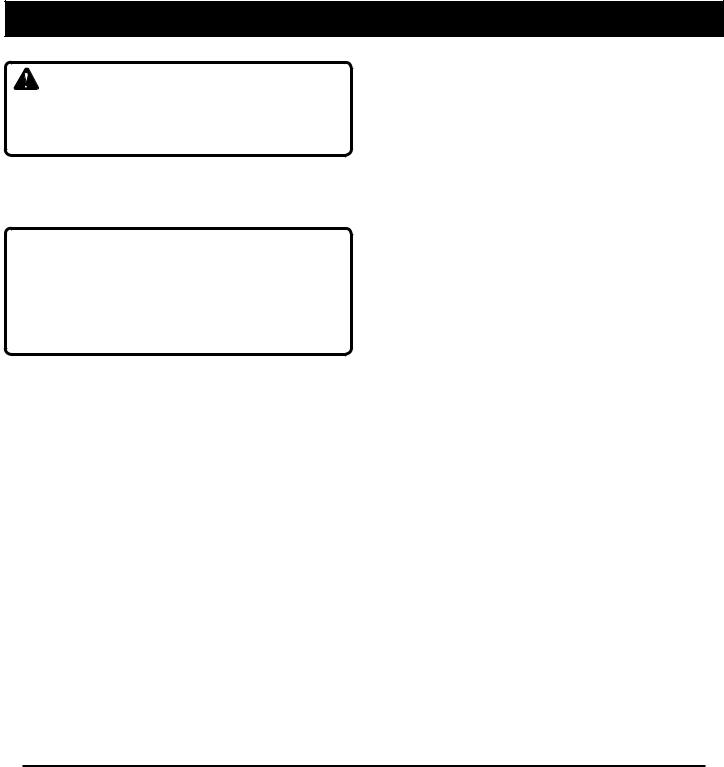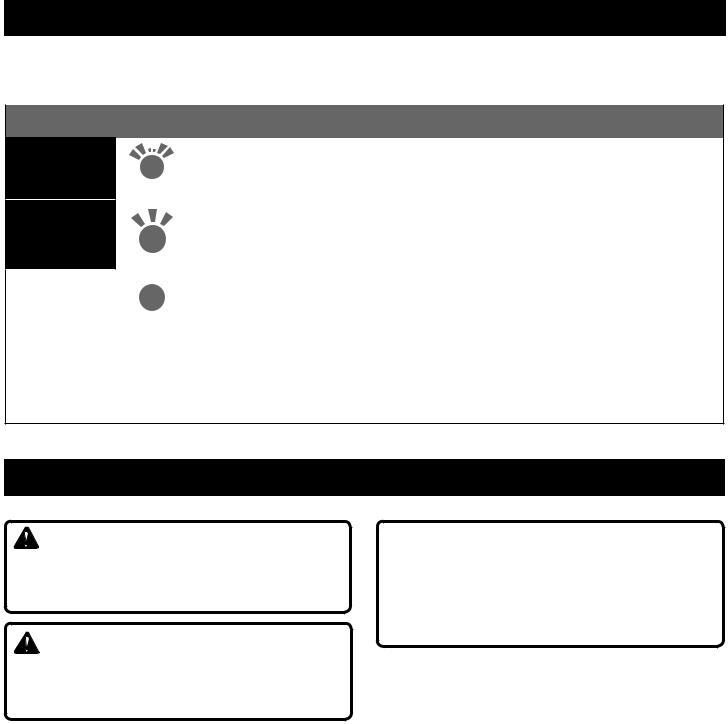Ryobi P119 User Manual [en, es, fr]

OPERATOR’S MANUAL
MANUEL D’UTILISATION
MANUAL DEL OPERADOR
18 V DUAL CHEMISTRY BATTERY CHARGER
CHARGEUR DE PILES À COMPOSITION CHIMIQUE DOUBLE DE 18 V
CARGADOR DE BATERÍA PARA
DOS TIPOS DE COMPUESTOS QUÍMICOS DE 18 V
P119
Safety Rules for Charger |
.....................2 |
Symbols.............................................. |
3 |
Assembly............................................ |
4 |
Operation......................................... |
4 -5 |
Maintenance....................................... |
5 |
Illustrations.......................................... |
6 |
Parts Ordering/Service......... |
Back page |
 WARNING: To reduce the risk of injury, the user must read and understand the operator’s manual before using this product.
WARNING: To reduce the risk of injury, the user must read and understand the operator’s manual before using this product.
SAVE THIS MANUAL FOR FUTURE REFERENCE
Règles de sécurité pour le chargeur...2 |
|
Symboles............................................ |
3 |
Assemblage........................................ |
4 |
Utilisation......................................... |
4-5 |
Entretien.............................................. |
5 |
Illustrations.......................................... |
6 |
Commande de pièces |
|
et réparation...................... |
Page arrière |
 AVERTISSEMENT : Pour réduire les risques de blessures, l’utilisateur doit lire et veiller à bien comprendre le manuel d’utilisation avant d’employer ce produit.
AVERTISSEMENT : Pour réduire les risques de blessures, l’utilisateur doit lire et veiller à bien comprendre le manuel d’utilisation avant d’employer ce produit.
CONSERVER CE MANUEL POUR FUTURE RÉFÉRENCE
Reglas de seguridad para el |
|
empleo del cargador |
.......................... 2 |
Símbolos............................................ |
3 |
Armado............................................... |
4 |
Funcionamiento............................... |
4 -5 |
Mantenimiento................................... |
5 |
Ilustraciones....................................... |
6 |
Pedidos de piezas |
|
y servicio........................ |
Pág. posterior |
 ADVERTENCIA: Para reducir el riesgo de lesiones, el usuario debe leer y comprender el manual del operador antes de usar este producto.
ADVERTENCIA: Para reducir el riesgo de lesiones, el usuario debe leer y comprender el manual del operador antes de usar este producto.
GUARDE ESTE MANUAL PARA FUTURAS CONSULTAS

SAFETY RULES FOR CHARGER
WARNING!
READ AND UNDERSTAND ALL INSTRUCTIONS. Failure to follow all instructions listed below, may result in electric shock, fire and/or serious personal injury.
Before using charger, read all instructions and cautionary markings in this manual, on charger, battery, and product using battery to prevent misuse of the products and possible injury or damage.
 WARNING:
WARNING:
Charge only one nickel-cadmium or lithium-ion rechargeable battery at a time. Other types of batteries may burst, causing personal injury or damage. For compatible battery packs see tool/appliance/battery pack/charger correlation supplement 987000-432.
Do not use charger outdoors or expose to wet or damp conditions. Water entering charger will increase the risk of electric shock.
Use of an attachment not recommended or sold by the battery charger manufacturer may result in a risk of fire, electric shock, or injury to persons. Following this rule will reduce the risk of electric shock, fire, or serious personal injury.
Do not abuse cord or charger. Never use the cord to carry the charger. Do not pull the charger cord rather than the plug when disconnecting from receptacle. Damage to the cord or charger could occur and create an electric shock hazard. Replace damaged cords immediately.
Make sure cord is located so that it will not be stepped on, tripped over, come in contact with sharp edges or moving parts or otherwise subjected to damage or stress. This will reduce the risk of accidental falls, which could cause injury, and damage to the cord, which could result in electric shock.
Keep cord and charger from heat to prevent damage to housing or internal parts.
Do not let gasoline, oils, petroleum-based products, etc. come in contact with plastic parts. They contain chemicals that can damage, weaken, or destroy plastic.
Always wear eye protection with side shields marked to comply with ANSI Z87.1. Failure to do so could result in objects being thrown into your eyes resulting in possible serious injury.
An extension cord should not be used unless absolutely necessary. Use of improper extension cord could result in a risk of fire and electric shock. If extension cord must be used, make sure:
a.That pins on plug of extension cord are the same number, size and shape as those of plug on charger.
b.That extension cord is properly wired and in good electrical condition; and
c.That wire size is large enough for AC ampere rating of charger as specified below:
Cord Length (Feet) |
25’ |
50’ |
100’ |
Cord Size (AWG) |
16 |
16 |
16 |
NOTE: AWG = American Wire Gauge
Do not operate charger with a damaged cord or plug, which could cause shorting and electric shock. If damaged, have the charger replaced by an authorized serviceman.
Do not operate charger if it has received a sharp blow, been dropped, or otherwise damaged in any way.
Take it to an authorized serviceman for electrical check to determine if the charger is in good working order.
Do not disassemble charger. Take it to an authorized serviceman when service or repair is required. Incorrect reassembly may result in a risk of electric shock or fire.
Unplug charger from outlet before attempting any maintenance or cleaning to reduce the risk of electric shock.
Disconnect charger from the power supply when not in use. This will reduce the risk of electric shock or damage to the charger if metal items should fall into the opening. It also will help prevent damage to the charger during a power surge.
Risk of electric shock. Do not touch uninsulated portion of output connector or uninsulated battery terminal.
Save these instructions. Refer to them frequently and use them to instruct others who may use this tool. If you loan someone this tool, loan them these instructions also to prevent misuse of the product and possible injury.
IMPORTANT SAFETY INSTRUCTIONS
1. SAVE THESE INSTRUCTIONS - DANGER: TO REDUCE RISK OF FIRE OR ELECTRIC SHOCK CAREFULLY FOLLOW THESE INSTRUCTIONS.
This manual contains important safety and operating instructions for battery charger P119.
2. Before using battery charger, read all instructions and cautionary markings on battery charger, battery, and product using battery.
3.  CAUTION: To reduce the risk of injury, charge only nickel-cadmium or lithium-ion rechargeable batteries. Other types of batteries may burst, causing personal injury or damage.
CAUTION: To reduce the risk of injury, charge only nickel-cadmium or lithium-ion rechargeable batteries. Other types of batteries may burst, causing personal injury or damage.
2 − English

SYMBOLS
The following signal words and meanings are intended to explain the levels of risk associated with this product.
SYMBOL |
SIGNAL |
MEANING |
|
|
|
|
DANGER: |
Indicates an imminently hazardous situation, which, if not avoided, will result |
|
in death or serious injury. |
|
|
|
|
|
|
|
|
WARNING: |
Indicates a potentially hazardous situation, which, if not avoided, could result |
|
in death or serious injury. |
|
|
|
|
|
|
|
|
CAUTION: |
Indicates a potentially hazardous situation, which, if not avoided, may result in |
|
minor or moderate injury. |
|
|
|
|
|
|
|
|
NOTICE: |
(Without Safety Alert Symbol) Indicates important information not related to an |
|
injury hazard, such as a situation that may result in property damage. |
|
|
|
Some of the following symbols may be used on this product. Please study them and learn their meaning. Proper interpretation of these symbols will allow you to operate the product better and safer.
SYMBOL |
NAME |
DESIGNATION/EXPLANATION |
|
Safety Alert |
Indicates a potential personal injury hazard. |
|
Read Operator’s Manual |
To reduce the risk of injury, user must read and understand |
|
operator’s manual before using this product. |
|
|
|
|
|
Eye Protection |
Always wear eye protection with side shields marked to comply |
|
with ANSI Z87.1. |
|
|
|
|
|
Wet Conditions Alert |
Do not expose to rain or use in damp locations. |
V |
Volts |
Voltage |
Hz |
Hertz |
Frequency (cycles per second) |
W |
Watt |
Power |
|
Alternating Current |
Type of current |
|
Direct Current |
Type or a characteristic of current |
CALIFORNIA PROPOSITION 65
 WARNING:
WARNING:
This product may contain chemicals, including lead, known to the State of California to cause cancer, birth defects, or other reproductive harm. Wash hands after handling.
3 − English

ASSEMBLY
WARNING: |
WARNING: |
Do not use this product if it is not completely assembled or if any parts appear to be missing or damaged. Use of a product that is not properly and completely assembled could result in serious personal injury.
Do not attempt to modify this product or create accessories not recommended for use with this product. Any such alteration or modification is misuse and could result in a hazardous condition leading to possible serious personal injury.
If any parts are damaged or missing, please call 1-800-525-2579 for assistance. In Mexico, please call 01-800-843-1111.
OPERATION
WARNING:
Do not allow familiarity with products to make you careless. Remember that a careless fraction of a second is sufficient to inflict serious injury.
WARNING:
Always wear eye protection with side shields marked to comply with ANSI Z87.1. Failure to do so could result in objects being thrown into your eyes resulting in possible serious injury.
APPLICATIONS
You may use this product for the following purposes: Charging Ryobi 18V Li-Ion or Ni-Cd batteries.
CAUTION:
If at any point during the charging process the LED does not light, remove the charger from the battery to avoid damaging the product. DO NOT insert another battery. Return the charger and battery to your nearest service center for service or replacement.
CHARGING
See figure 1, page 6.
Battery packs are shipped in a low charge condition to prevent possible problems. Therefore, you should charge them before first use. If the charger does not charge the battery pack under normal circumstances, return both the battery pack and charger to your nearest repair center for electrical check.
Charges battery packs in as little as 8 hours, depending upon the type of battery pack.
Make sure the power supply is normal household voltage,
120 volts, AC only, 60 Hz.
Connect the charger to a power supply.
Attach the battery pack to the charger by aligning the raised ribs on the battery pack with the grooves in the charger, then slide the charger onto the battery pack.
Press down on the charger to be sure contacts on the battery pack engage properly with contacts in the charger.
Do not place the charger in an area of extreme heat or cold. It will work best at normal room temperature.
The battery pack may become slightly warm to the touch while charging. This is normal and does not indicate a problem.
After charging is complete, the LED will remain on while the charger is in Maintenance mode.
Charger will periodically wake from Energy Save mode to ensure the battery pack remains in a fully charged state.
When the battery pack is fully charged, remove the charger.
CHARGING A HOT BATTERY PACK
When using a tool continuously, the battery pack may become hot. The charger may be placed onto a hot battery pack but charging will not begin until the battery temperature cools to within acceptable temperature range. When the charger is placed on a hot battery pack, the LED will flash in the “Evaluate” pattern - two quick pulses followed by a pause. When the battery pack cools, the charger will automatically begin charging.
CHARGING A COLD BATTERY PACK
The charger may be placed onto a cold battery pack but charging will not begin until the battery temperature warms to within acceptable temperature range. When the charger is placed on a cold battery pack, the LED will flash in the “Evaluate” pattern - two quick pulses followed by a pause. When the battery pack warms the charger will automatically begin charging.
4 − English

OPERATION
LED FUNCTIONS
See Figure 1, page 6.
MODE |
LED |
ACTION |
|
|
|
Evaluating |
|
Battery is being tested. If voltage is low, battery is being conditioned and will begin charging when |
|
normal voltage is reached. If battery is hot or cold, charger will begin charging when temperature |
|
|
Flashing |
reaches an appropriate level. |
|
|
|
Charging |
|
Battery is being charged. |
|
Flashing |
|
Charged |
|
Battery pack is fully charged and charger is in Energy Save mode. |
|
On |
|
|
|
|
•If charger indicates “Evaluate” for longer than 30 minutes at room temperature, battery pack may be defective. Try to repeat the conditions a second time by removing and reintalling the battery pack. If the LED status repeats a second time, try charging a different battery.
•If a different battery charges normally, dispose of the defective pack (see battery pack operator’s manual).
•If a different battery also indicates “Evaluate” for longer than 30 minutes, the charger may be defective.
MAINTENANCE
WARNING:
When servicing, use only identical replacement parts. Use of any other parts could create a hazard or cause product damage.
WARNING:
To avoid serious personal injury, always remove the battery pack from the tool when cleaning or performing any maintenance.
 WARNING:
WARNING:
Do not at any time let brake fluids, gasoline, petroleumbased products, penetrating oils, etc., come in contact with plastic parts. Chemicals can damage, weaken or destroy plastic which could result in serious personal injury.
STORAGE
Always remove the battery pack before storing the charger or any time the charger is unplugged.
GENERAL MAINTENANCE
Avoid using solvents when cleaning plastic parts. Most plastics are susceptible to damage from various types of commercial solvents and may be damaged by their use. Use clean cloths to remove dirt, dust, oil, grease, etc.
This product has a Three-Year Limited Warranty.
Warranty details are available at www.ryobitools.com
NOTE: ILLUSTRATIONS START ON PAGE 6 AFTER FRENCH AND SPANISH LANGUAGE SECTIONS
5 − English
